In museums, “conservation” usually refers to scientific and technical methods of restoring and preserving objects. Conserving the Witness Blanket has involved taking a collaborative, decolonizing approach to the items and stories it carries. This includes respecting intangible histories and meanings as well as the natural impermanence of many of its elements.
Caring for the Witness Blanket
A decolonizing approach to conserving Indigenous artwork
By
Skylar Wall, Cindy Colford, Carolyn Sirett, Stephanie Chipilski and Carey Newman
Published: May 15, 2023
Tags:
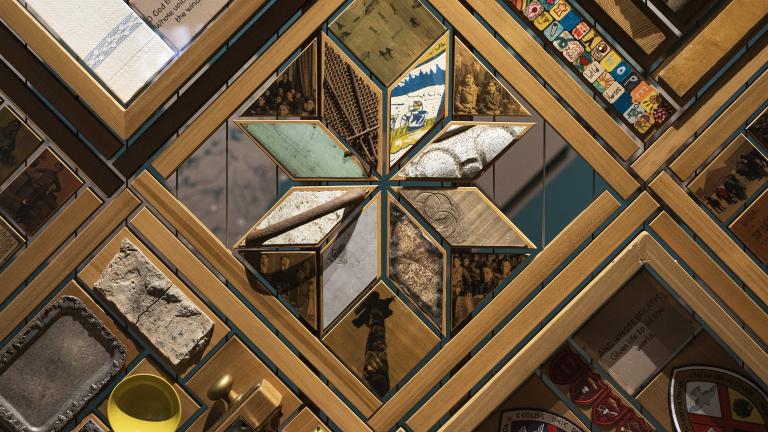
Photo: CMHR, Aaron Cohen
Story text
The Witness Blanket is a large‐scale work of art inspired by a woven blanket. It stands as a national monument to recognize the atrocities of Canada’s Indian residential school era.
A unique stewardship agreement (PDF download) governs the care and display of the Witness Blanket. In it, artist Carey Newman and the Canadian Museum for Human Rights (CMHR) commit to preserve and protect the Blanket. They commit to take physical and spiritual care of the Blanket, to honour the stories it carries, and to act in the best interests of the Blanket itself.
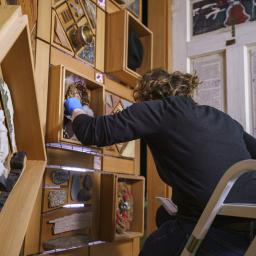
In 2019–2022, the Museum undertook an extensive preservation and conservation project to take care of this complex work of art. The Museum worked with staff from the Canadian Conservation Institute to understand the care required and enlisted the expertise of the conservation team from the Manitoba Museum to lead this project.
The conservation project team and Carey Newman worked together on a decolonizing approach to caring for the Witness Blanket. Historically, museums have imposed oppressive colonial worldviews and practices in their treatment of Indigenous peoples and cultural heritage. Taking a decolonizing approach means overturning that harmful legacy and ensuring that collections care and conservation operate in genuine dialogue with Indigenous worldviews and culture. Below, the team members reflect on the project and its social, professional and personal importance.
Skylar Wall
Conservation Intern, Canadian Museum for Human Rights
It’s a strange feeling to work on the Witness Blanket. To look upon a mural of injustice. To see the remnants of a school your friends and your relatives went to and know the exact stories behind them. To see their faces behind every object. To hear the Blanket cry when no one else is around.
You’d expect to become desensitized to the experience after three months. That the routine of clocking in and clocking out and using the gallery as a workplace would buff out those edges. But it’s the opposite. Those edges only grow sharper when you work a full shift with the eyes of Survivors, perpetrators and those who never made it home staring down at you. The eyes of visitors – both those who are just learning what a residential school is and those who are intimately familiar – watching you work. And on all their lips the same question: Why? “Why are you here? Why are you working on this? Why did this happen to us?” You are constantly reminded of what the artwork represents and the legacy you have been tasked with preserving.
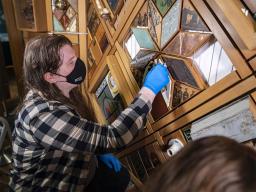
The hardest part about working in public was the children. Seeing the confusion in their eyes and the hushed tones of their caregiver trying to find a way to explain what all of this means. I used to dread the day that a child, one of my relatives, would come up to me and ask me what the Witness Blanket meant. The reality is that they already know. It’s the first thing we learn. You can look upon an empty container and, without knowing what used to fill it or how it was emptied, know that something is missing. That something has been taken from it. This is how we grew up: scrounging for scraps in an empty container, cherishing what we could find and praying that it would last us until the next morning. Our children already know the pain of the absence they inherit.
The Witness Blanket is a mirror. Every piece carved into the cedar has also been carved into our bones. The words and photos transferred onto the cedar blocks are tattooed onto our skin. The stories told across the Blanket come from our tongues. They live deep down inside our hearts. The Blanket reflects who we are and allows others to be introduced to us.
This is my experience of conservation on the Witness Blanket. All the work I have done on the physical conservation of the Blanket —the cleaning, reporting, and treating — was a means to an end. The true work was in the conservation of our legacy. The pressures I felt were not in how well I could report on the condition of a book or in how spotless I could make a stretch of cedar, but in how well I could ensure that the story of my friends, my family, my people—the story of myself—is not forgotten.
The stories told across the Blanket come from our tongues. They live deep down inside our hearts.
Cindy Colford
Manager of Collections and Conservation, Manitoba Museum
In late February 2021, I received a call from Helen Delacretaz, then Director, Exhibitions at the CMHR. She described a project the CMHR was undertaking and asked if the Manitoba Museum’s conservation team would participate. Over the next several months, we defined the details and signed a memorandum of understanding. The Manitoba Museum would manage, direct, perform and oversee the conservation of the Witness Blanket.
The primary focus of conserving artifacts is not unusual. We do this work every day. What was unusual, and what was perhaps the most important part of the arrangement, was that both museums committed to undertaking this work in the spirit of care expressed in the Witness Blanket stewardship agreement between the CMHR and artist Carey Newman. This meant we would incorporate Indigenous cultural traditions and protocols in its care and preservation.
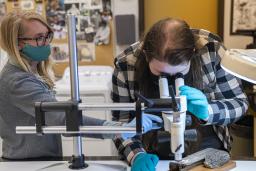
This project involved both personal and professional growth. It meant working within an unusual framework that involved a national museum, a provincial museum and an independent artist. This collaboration constantly demanded that we consider the preservation of both the tangible and intangible aspects of the work. We also committed to share this unique preservation experience with Indigenous trainees to create educational opportunities in the fields of collections management and conservation. This was well aligned with both my own experience and the Manitoba Museum’s long history of training and mentorship.
For me, the opportunity to participate in this project was more than just providing a service to undertake the conservation of the artwork. It meant taking part in the larger issues of dialogue and engagement guided by commitment to reconciliation.
This collaboration constantly demanded that we consider the preservation of both the tangible and intangible aspects of the work.
Carolyn Sirett
Conservator, Manitoba Museum
Our purpose that first day in May when Cindy and I travelled from one museum to the other was to introduce ourselves to the Witness Blanket. We wanted to get a better understanding of the objects, the artist Carey Newman and his intentions for creating the artwork. When I first walked into that room and saw the Witness Blanket, I was in awe of what was standing in front of me: all these objects, the quilted patterned design, the sheer scale, the craftsmanship, and the audio playing in the background.
How are we going to preserve this? How do we use the expertise we have been given to care and preserve so that others can experience this living artwork? And how can we ensure that our actions in preservation are done in a meaningful way? At that moment, I did not have the answers. Over the course of the coming months, I was humbled by my experience with working on the Witness Blanket, which has shifted my core thinking as a conservator in this ever‐evolving professional field.
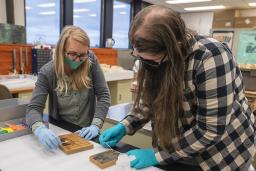
Conservators are analytical individuals. We have a technical and meticulous focus on the objects we are treating or repairing on our workbenches. We look at an object and see deterioration, cracks, splits or missing components that we are eager to fix. We try to understand how the object was created and the materials it is composed of. But the one thing we sometimes miss is the story we cannot see.
This invisible story involves the people who touched, held or viewed the object in the past. It’s the story of the people who cherished something so much that they rubbed all the paint off in a loving way or had an experience so terrifying that it left scratches on an object. I have come to realize that we need to look more closely and imaginatively to understand the stories we cannot always see and that represent so much more. We need to act in a more collaborative way and integrate those stories into our preservation decisions.
As I worked in the galleries a few days a week, it became clear that the child’s shoe is an object that draws many visitors. This tiny shoe, wrapped in red cloth for healing, has tiny lichen growths, in all life stages, covering its leather body. At first, I looked at the shoe as I always would – to determine what is it made of, what signs of damage need to be mitigated and what solutions might we use during treatment. We contacted botanists, lichen experts, and other conservators in the field. Should we coat it in something to freeze it in time? What are all the possible coatings?

But then, we took a moment to pause and went back to what Carey told us in the beginning. These objects are living and we should be conscious about what we put on top of these living pieces. So, what would be the best kind of preservation for a living object? The answer we came to in the end might appear to be the simplest. We would ensure the environment surrounding the shoe is stable and then continue to monitor it as it changes over time. Sometimes the smallest actions have the greatest effects in the end.
As a non‐Indigenous woman, I am on my own path of understanding reconciliation and how I can be a part of change as a conservator. Working on the Witness Blanket has allowed me to take away many teachings. The biggest teaching is to be open and honest in communicating what actions we are taking when treating Indigenous objects, and to make the effort to understand and respect their stories.
I have come to realize that we need to look more closely and imaginatively to understand the stories we cannot always see and that represent so much more.
Stephanie Chipilski
Conservation Technician and Assistant Registrar, Canadian Museum for Human Rights
It is a challenge to succinctly explain the imprint helping preserve the Witness Blanket has left on my life as a museum professional and Canadian. When I first experienced the artwork, I was overwhelmed by its size, scope, and national significance. It captures all your senses, and any detail can spark a connection, question, or self‐reflection.
I am grateful for Carey Newman’s guidance and perspectives on preserving and caring for the artwork. I am indebted to the team who collected and created Witness Blanket for the wealth of information and dialogue they created and recorded in documenting the stories it carries*. (We generally used the terms “pieces” and “stories” rather than “artifacts” in this project. The terms decolonize common museum language and help represent the materials as having living qualities, representing the past, present and future.)
Participating in this teamwork, taking decolonizing approaches, and engaging the public through in‐gallery conservation created an uncommon opportunity that offered me immense learnings.

Doing conservation within a public exhibition and alongside the multimedia elements that accompany the Blanket has impacted my work. Mid task, I would be drawn in by the Picking Up the Pieces documentary and its voices would help guide my work. Listening to Victor Newman, I learn why there is a tree branch with saw marks on the Blanket. I watch the extensive ceremony, vibrant landscape and raw emotion on Ellen and Marion Newman’s faces as their braids are shorn. I see where the shoe covered in lichen and spores was retrieved on the site of Carcross Residential School. Seeing its story tells me about changes in its condition and why it was bound with red fabric and surrounded with medicines by the Witness Blanket team.
Working in this way melts away feelings of distance. I become intimate with the intangible qualities of the pieces in front of me. It creates a natural and constant dialogue on how to best preserve the stories they hold by supporting but respecting their natural lifespan. I am raw with emotion as I understand more details surrounding each panel, fragment of furniture and photograph.
Over months spent in the gallery, I had many conversations with visitors from Canada and abroad. People would approach the worktable to ask about what I was dusting, photographing, or documenting. More frequently, they wanted to express a thought or feeling brought on by the artwork. There were somber days of thinking about unmarked graves and how many years it took for the general public to become aware of them. There were hopeful days discussing award‐winning Indigenous‐language books and music and upcoming community gatherings. On numerous occasions people made a discovery – a sweater, a sign fragment, a quote – of personal connection, revelation, or regret.
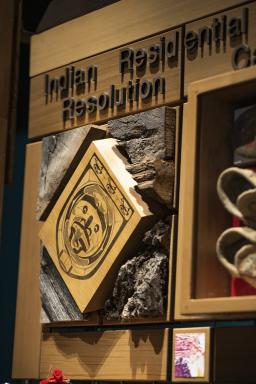
I learned how to help or respond, when I could, because sometimes I, too, was overcome with emotion. Once again, the living qualities that I was attempting to preserve were very much apparent in people’s responses to the physical presence of items on the Blanket. Day after day I saw how people were impacted by the pieces, the stories they hold, and the purposes they have in our lives.
Our conservation work is not attempting to freeze the Witness Blanket in time. The physical pieces on the Blanket will continue to age at different rates. But efforts to preserve its content will continue, whether by ongoing public conservation, educational programming, or digital storytelling.
As a museum professional, I know I have specialized tools and resources to contribute, but the cultural materials that define our past and present are carried by the efforts of teams of people. Working on this project reminded me of the role I have as a citizen participating in collective memory. We can all can bear witness. We can all preserve and carry forward pieces of the past into the future.
Working on this project reminded me of the role I have as a citizen participating in collective memory.
Carey Newman / Hayalthkin'geme
I want to share a note of gratitude for the conservation team, the Manitoba Museum and the Canadian Museum for Human Rights. This was an incredible project to participate in, and the care and consideration of culture that was brought to the process was important and meaningful.
By following living cultural protocols throughout the conservation and restoration of the Witness Blanket, we were enacting the varied and unique perspectives of Indigenous peoples, ensuring that this project didn’t perpetuate or participate in the patriarchal views of colonialism.
The ongoing efforts to understand these objects through the values and imperatives of the communities they came from – and in some cases the perspective and purpose of the objects themselves – embrace and support the vitality of cultural resurgence.
This change in perspective shifts the gaze of conservation practice from caring for artifacts as delicate, but inanimate relics of bygone history, to recognizing their living interconnectedness across the past, present and future. It centres the vitality and worldviews of Indigenous cultures and peoples. It honours the reality that we have not merely survived, but continue to evolve and grow, maintaining our connections to the significance and meaning of our material culture.
Perhaps most importantly, this acknowledges we are still here, and that we are made of more than our traumas. We are the culmination of our resilience, our stories, our wisdom, our languages, our cultures, our joy, our pain, our beauty, and the many possibilities that our futures hold.
Ask yourself
How do your local museums address colonialism?
Where other than museums do we learn about the past?
What objects would let someone in the future understand your life?
Learn more
The Witness Blanket
This monumental work of art honours Survivors of Canada’s residential schools. A new website lets you learn from their experiences and bear witness to their stories.
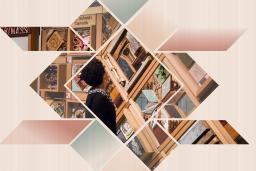
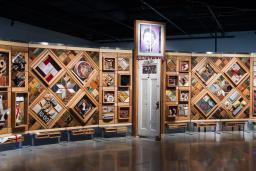
Canada’s Indian residential schools: Childhood denied
A story about Indian residential schools and their legacy

Suggested citation
Suggested citation : Skylar Wall, Cindy Colford, Carolyn Sirett, Stephanie Chipilski and Carey Newman. “Caring for the Witness Blanket.” Canadian Museum for Human Rights. Published May 15, 2023. https://humanrights.ca/story/caring-witness-blanket